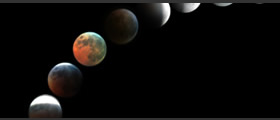Lunar Eclipses
3.9 - Understand the appearance of the Moon during partial and total lunar eclipses, including the terms first, second, third and fourth umbral contactLunar eclipses take place when the Moon enters Earth's shadow. First to last contact can last several hours however totality lasts up to 1 hour 42 minutes. This is larger than a solar eclipse because the Earth is larger than the Moon. Totality can be observed by most observers on the night hemisphere of the Earth, not necessarily along a line of totality like a solar eclipse.
A lunar eclipse only takes place during a full Moon when the Moon is on the opposite side of the Earth from the Sun.
Total Lunar Eclipse
First Contact
The Moon enters Earth's penumbra and a partial lunar eclipse occurs. The moon may appear darker or greyer at this point.
Second Contact
The Moon moves into the Earth's umbra. Sunlight passing through Earth's atmosphere refracts (bends) red light onto the Moon's surface. The colour depends on atmospheric conditions on Earth. Other observed colours are copper, orange, or dull burgundy.
Third Contact
The Moon moves out of the Earth's umbra.
Fourth Contact
The Moon moves out of the Earth's penumbra.
PARTIAL ECLIPSE
A partial lunar eclipse occurs when the Earth's shadow intrudes into the disc of the Moon but does not block it entirely as in a total lunar eclipse. Sometimes partial eclipses happen at the same time as total lunar eclipses but are partial to an observer due to the rotation of the Earth and the time of moonrise and moonset.
Animation
Summary
- Takes place over hours
- Visible from hemisphere facing moon
- Colour caused by refraction of Earth's atmosphere
Questions
- Draw a diagram with labels of a Lunar eclipse.
- Write down times and appearance of the Moon.
Did you know?
- Lunar eclipses occur during a full Moon.
- Lunar eclipses can be seen from any part of Earth facing the Moon and so are useful to calculate longitude if measured accurately.
Links
- Keith's Lunar Eclipse Page Keith's Lunar Eclipse Page
- NASA Eclipse Find the next lunar eclipse!




 | © All Rights Reserved |
| © All Rights Reserved |